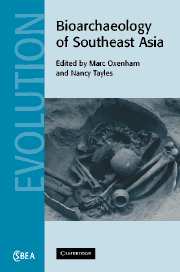Book contents
- Frontmatter
- Contents
- List of contributors
- Foreword: Emerging frontiers in the bioarchaeology of Southeast Asia
- Preface
- 1 Introduction: Southeast Asian bioarchaeology past and present
- Part I Morphological diversity, evolution and population relationships
- 2 The population history of Southeast Asia viewed from morphometric analyses of human skeletal and dental remains
- 3 A multivariate craniometric study of the prehistoric and modern inhabitants of Southeast Asia, East Asia and surrounding regions: a human kaleidoscope?
- 4 Interpretation of craniofacial variation and diversification of East and Southeast Asians
- 5 New perspectives on the peopling of Southeast and East Asia during the late upper Pleistocene
- 6 Human variation and evolution in Holocene Peninsular Malaysia
- 7 Dentition of the Batak people of Palawan Island, the Philippines: Southeast Asian Negrito origins
- Part II Health, disease and quality of life
- Part III Conclusions
- Index
- References
2 - The population history of Southeast Asia viewed from morphometric analyses of human skeletal and dental remains
Published online by Cambridge University Press: 18 November 2009
- Frontmatter
- Contents
- List of contributors
- Foreword: Emerging frontiers in the bioarchaeology of Southeast Asia
- Preface
- 1 Introduction: Southeast Asian bioarchaeology past and present
- Part I Morphological diversity, evolution and population relationships
- 2 The population history of Southeast Asia viewed from morphometric analyses of human skeletal and dental remains
- 3 A multivariate craniometric study of the prehistoric and modern inhabitants of Southeast Asia, East Asia and surrounding regions: a human kaleidoscope?
- 4 Interpretation of craniofacial variation and diversification of East and Southeast Asians
- 5 New perspectives on the peopling of Southeast and East Asia during the late upper Pleistocene
- 6 Human variation and evolution in Holocene Peninsular Malaysia
- 7 Dentition of the Batak people of Palawan Island, the Philippines: Southeast Asian Negrito origins
- Part II Health, disease and quality of life
- Part III Conclusions
- Index
- References
Summary
Introduction
The population history of Southeast Asia is complex because of the various migration processes and the intermixing of populations since prehistoric times. The limited number of prehistoric human remains and uncertainty over their dating are additional problems in studies of this region. In general terms, Southeast Asia is thought to have been originally occupied by indigenous people (sometimes referred to as Australo-Melanesians), who exchanged genes with immigrants from north and/or east Asia leading to the formation of present day Southeast Asians (van Stein Callenfels 1936, Mijsberg 1940, von Koenigswald 1952, Coon 1962, Jacob 1967, Bellwood 1987, 1989, 1996, 1997, Brace et al. 1991). It should be noted that the term Australo-Melanesian is commonly used to refer to either the recent indigenous people of Australia, New Guinea and island Melanesia or the people of that regional phenotype. This population history scenario for Southeast Asia is known as the Immigration or Two-layer model. The Two-layer hypothesis is supported by a wide range of genetic, linguistic and archaeological evidence. Classic genetic markers and recent mitochondrial DNA analyses (Ballinger et al. 1992, Cavalli-Sforza et al. 1994, Omoto and Saitou 1997, Tan 2001) have found many biological similarities between Chinese and Southeast Asian samples.
- Type
- Chapter
- Information
- Bioarchaeology of Southeast Asia , pp. 33 - 58Publisher: Cambridge University PressPrint publication year: 2006
References
- 16
- Cited by



